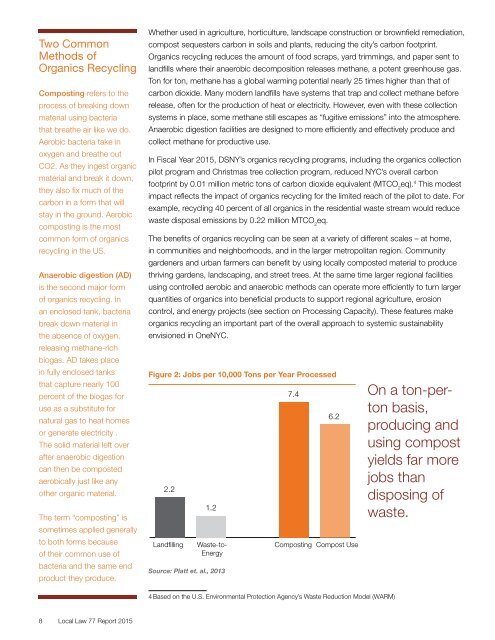2015 NYC Organics Collection Report
1jcwPY1
1jcwPY1
You also want an ePaper? Increase the reach of your titles
YUMPU automatically turns print PDFs into web optimized ePapers that Google loves.
Two Common<br />
Methods of<br />
<strong>Organics</strong> Recycling<br />
Composting refers to the<br />
process of breaking down<br />
material using bacteria<br />
that breathe air like we do.<br />
Aerobic bacteria take in<br />
oxygen and breathe out<br />
CO2. As they ingest organic<br />
material and break it down,<br />
they also fix much of the<br />
carbon in a form that will<br />
stay in the ground. Aerobic<br />
composting is the most<br />
common form of organics<br />
recycling in the US.<br />
Anaerobic digestion (AD)<br />
is the second major form<br />
of organics recycling. In<br />
an enclosed tank, bacteria<br />
break down material in<br />
the absence of oxygen,<br />
releasing methane-rich<br />
biogas. AD takes place<br />
in fully enclosed tanks<br />
that capture nearly 100<br />
percent of the biogas for<br />
use as a substitute for<br />
natural gas to heat homes<br />
or generate electricity .<br />
The solid material left over<br />
after anaerobic digestion<br />
can then be composted<br />
aerobically just like any<br />
other organic material.<br />
The term “composting” is<br />
sometimes applied generally<br />
to both forms because<br />
of their common use of<br />
bacteria and the same end<br />
product they produce.<br />
Whether used in agriculture, horticulture, landscape construction or brownfield remediation,<br />
compost sequesters carbon in soils and plants, reducing the city’s carbon footprint.<br />
<strong>Organics</strong> recycling reduces the amount of food scraps, yard trimmings, and paper sent to<br />
landfills where their anaerobic decomposition releases methane, a potent greenhouse gas.<br />
Ton for ton, methane has a global warming potential nearly 25 times higher than that of<br />
carbon dioxide. Many modern landfills have systems that trap and collect methane before<br />
release, often for the production of heat or electricity. However, even with these collection<br />
systems in place, some methane still escapes as “fugitive emissions” into the atmosphere.<br />
Anaerobic digestion facilities are designed to more efficiently and effectively produce and<br />
collect methane for productive use.<br />
In Fiscal Year <strong>2015</strong>, DSNY’s organics recycling programs, including the organics collection<br />
pilot program and Christmas tree collection program, reduced <strong>NYC</strong>’s overall carbon<br />
footprint by 0.01 million metric tons of carbon dioxide equivalent (MTCO 2<br />
eq). 4 This modest<br />
impact reflects the impact of organics recycling for the limited reach of the pilot to date. For<br />
example, recycling 40 percent of all organics in the residential waste stream would reduce<br />
waste disposal emissions by 0.22 million MTCO 2<br />
eq.<br />
The benefits of organics recycling can be seen at a variety of different scales – at home,<br />
in communities and neighborhoods, and in the larger metropolitan region. Community<br />
gardeners and urban farmers can benefit by using locally composted material to produce<br />
thriving gardens, landscaping, and street trees. At the same time larger regional facilities<br />
using controlled aerobic and anaerobic methods can operate more efficiently to turn larger<br />
quantities of organics into beneficial products to support regional agriculture, erosion<br />
control, and energy projects (see section on Processing Capacity). These features make<br />
organics recycling an important part of the overall approach to systemic sustainability<br />
envisioned in One<strong>NYC</strong>.<br />
Figure 2: Jobs per 10,000 Tons per Year Processed<br />
2.2<br />
Landfilling<br />
1.2<br />
Waste-to-<br />
Energy<br />
Source: Platt et. al., 2013<br />
7.4<br />
6.2<br />
Composting Compost Use<br />
On a ton-perton<br />
basis,<br />
producing and<br />
using compost<br />
yields far more<br />
jobs than<br />
disposing of<br />
waste.<br />
4 Based on the U.S. Environmental Protection Agency’s Waste Reduction Model (WARM)<br />
8 Local Law 77 <strong>Report</strong> <strong>2015</strong>


